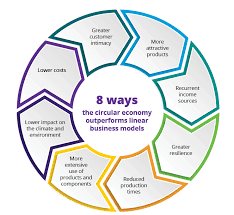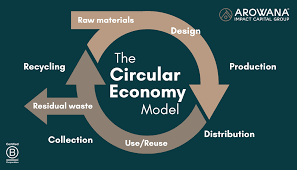CIRCULAR ECONOMY
A circular economy is a model of production and consumption that aims to reduce waste and pollution. It’s a closed-loop system that keeps materials and products in use for as long as possible.
How it works
- Reduce: Use fewer resources and materials
- Reuse: Share, lease, or maintain existing products
- Repair: Fix products instead of throwing them away
- Remanufacture: Remake products using materials from recycled products
- Recycle: Reduce products to their basic materials so they can be remade
- Compost: Use waste materials as regenerative resources for nature
Benefits
- Reduces waste, pollution, and carbon emissions
- Improves productivity of resources
- Tackles climate change, biodiversity loss, and waste
- Extends the life cycle of products
Other terms Regenerative economy, Closed-loop economy, Zero-waste economy, and Cradle-to-cradle economy.
Circular economy strategies
Circular economy strategies can be applied at various scales, from individual products to entire industries and cities
KEY TECHNOLOGIES:
Key technologies for a circular economy include digital technologies, artificial intelligence (AI), and blockchain.
Digital technologies
- Internet of Things: A key enabler for a circular economy
- Big data and analytics: Helps identify patterns and optimize processes
- Additive manufacturing and 3D printing: Helps extend product life cycles
Artificial intelligence (AI)
- Helps with material recovery, waste sorting, and resource allocation
- Helps minimize environmental impact and maximize resource efficiency
Blockchain
- Helps enhance transparency and accountability
- Helps track the flow of resources, materials, and products
- Helps authenticate product provenance, material composition, and sustainability claims
- Helps automate processes such as recycling, remanufacturing, and product reuse
The circular economy is a system that aims to keep materials in circulation and minimize waste, pollution, and carbon emissions. It’s based on the principles of reduce, reuse, and recycle.
The circular economy can help tackle climate change and other global challenges, like biodiversity loss and waste.
ADVANTAGES OF CIRCULAR ECONOMY:
The circular economy has many advantages, including environmental, economic, and social benefits. However, it also faces challenges.
Advantages
- Environmental benefits: Reduces waste, pollution, and greenhouse gas emissions
- Economic benefits: Creates new jobs and industries, and reduces costs
- Innovation: Stimulates new business models and technologies
- Consumer savings: Consumers have access to more durable and innovative products
- Social benefits: Builds a more sustainable world by integrating environmental, economic, and social factors
Challenges Requires innovative approaches and technologies, Requires rethinking consumption patterns, and Requires businesses to shift operations to meet new principles.

USES OF CIRCULAR ECONOMY:
A circular economy helps protect the environment, reduce waste, and create a more sustainable future. It can also help reduce greenhouse gas emissions, create jobs, and save money for consumers.
Environmental benefits
- Reduce waste Circular economy aims to reduce waste by reusing, recycling, and repairing products.
- Reduce emissions Circular economy can reduce emissions by reducing the use of fossil fuels and nonrenewable resources.
- Reduce resource consumption Circular economy can reduce the consumption of natural resources by reusing local resources.
- Regenerate nature Circular economy can help regenerate nature by using regenerative agriculture and natural colorings and dyes.
Economic benefits
- Create jobs Circular economy can stimulate the development of a more innovative and competitive industrial model.
- Save money for consumers Circular economy can save money for consumers by reducing the cost of healthcare and climate change.
- Promote resource independence Circular economy can promote resource independence by reducing dependence on imported raw materials.

Other benefit
- Improve materials Circular economy can improve materials by redesigning materials and products to be less resource intensive.
- Improve energy efficiency Circular economy can improve energy efficiency by reducing the use of fossil fuels.

